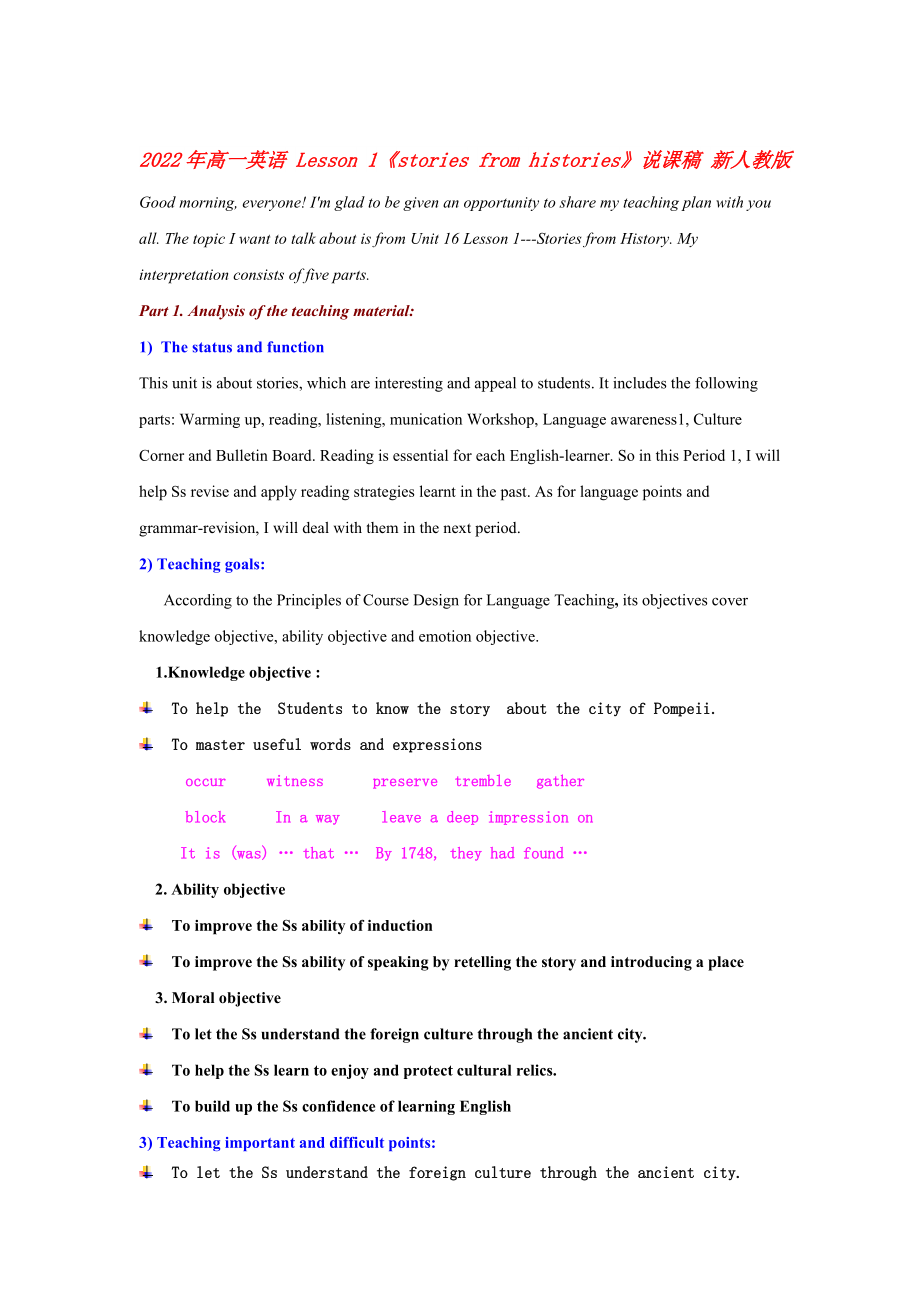《2022年高一英語 Lesson 1《stories from histories》說課稿 新人教版》由會員分享���,可在線閱讀�,更多相關(guān)《2022年高一英語 Lesson 1《stories from histories》說課稿 新人教版(4頁珍藏版)》請在裝配圖網(wǎng)上搜索���。
1��、
2022年高一英語 Lesson 1《stories from histories》說課稿 新人教版
Good morning, everyone! I'm glad to be given an opportunity to share my teaching plan with you all. The topic I want to talk about is from Unit 16 Lesson 1---Stories from History. My interpretation consists of five parts.
Part 1. Analysis of th
2��、e teaching material:
1) The status and function
This unit is about stories, which are interesting and appeal to students. It includes the following parts: Warming up, reading, listening, munication Workshop, Language awareness1, Culture Corner and Bulletin Board. Reading is essential for each Eng
3�����、lish-learner. So in this Period 1, I will help Ss revise and apply reading strategies learnt in the past. As for language points and grammar-revision, I will deal with them in the next period.
2) Teaching goals:
According to the Principles of Course Design for Language Teaching, its objectives
4�、cover knowledge objective, ability objective and emotion objective.
1.Knowledge objective :
l To help the Students to know the story about the city of Pompeii.
l To master useful words and expressions
occur witness preserve tremble gather bloc
5�����、k In a way leave a deep impression on
It is (was) … that … By 1748, they had found …
2. Ability objective
l To improve the Ss ability of induction
l To improve the Ss ability of speaking by retelling the story and introducing a place
3. Moral objective
l To let the Ss understan
6、d the foreign culture through the ancient city.
l To help the Ss learn to enjoy and protect cultural relics.
l To build up the Ss confidence of learning English
3) Teaching important and difficult points:
l To let the Ss understand the foreign culture through the ancient city.
l To help the Ss
7���、learn to enjoy and protect cultural relics.
l To build up the Ss’ confidence of learning English
Part 2
Methods of teaching and learning
1) Teaching methods:
l Task-based teaching method --- assign tasks
According the Ss’ level and learn step by step
l Discussion to help the Ss solve questi
8、ons
by themselves--- divide the whole class into
six groups according to their English level
2)Learning methods
l To understand the text by themselves with
pratical reading skills
l To study independently ,cooperatively and
petitively
l To taste the joy of success , be confident
and ha
9����、ve more enthusiasm in learning English
3)Teaching?Aids
Multi-media puter; software: Power point
Part 3 Analysis of the students
In order that the students can make progress in English and have interest in the historical story�, we mainly talk about the introductions of different kinds of stories
10、. In class, I will let the students know about the topic and encourage them to describe what they saw and happened in their lives. Reading through the story is also a good kind way of learning the past.
Based on over a year of senior English study, the students have adapted themselves to English
11�����、learning through various activities, and they have acquired some independent and cooperative learning abilities. However, in the countryside there is no environment to learn English, so they should have more chances to practise.
Besides, because this lesson is about reading and speaking, it must
12�����、 be helpful for the students to improve their skills and spoken English.
?Part 4 Teaching Procedure
1)Step 1. Organization and revision
Use pictures help the students talk about different kinds of stories to review what learned in the last lesson.
2) Step2 presentation
Play a short part of
13�����、 a video about volcanic eruption and let the Ss predict what happened in the city.
3)Step3 scanning
Ask Ss to skim the passage and see if their predictions are correct. At the same time, they should grasp the main idea of each paragraph.
Answer five questions
1 What is the article about ?
2.
14、 When does the story of Pompeii begin ?
3. Why does the article describe Pompeii as a “ time capsule ” ?
4. Who left a record of the eruption of Mount Vesuvius ?
5. What had Pompeii been like before the eruption ?
4)Step 4 fast reading
Read through the text again and try to guess the meani
15�、ng of the following words according to the context Witness
Occur Block out Preserve Uncover
Be caught in fort
5)Step5 detailed reading
n Read paragraph 4 and 5 carefully
n Look at the pictures and feel the last moment .
6)Step 6. Consolidation
Retell the story of the city
16���、Pompeii with the
help of the answers to the questions in Step 5,
Which make up the main idea of the story.
Part 5 Summary and homework課堂檢測
Pompeii be a booming city near a volcano named Vesuvius. However, the volcano s on August 24th of 79 AD ,
17、 nearly destroyed the whole city. And then Pompeii was buried under the ashes and disappeared . Finally was forgotten by the world. Archaeologists didn’t start to dig out the city s1748. Not on
18��、ly do the buildings and objects of Pompeii attract the people, the body shapes of the people caught in the disaster tourists imagine what the people were doing when they faced it. Today, tourists and scientists visit Pompeii every year more about the ancient world. In this way, the city lives on nearly 2,000 years after its .
That's all.Thank you for your listening.
 2022年高一英語 Lesson 1《stories from histories》說課稿 新人教版
2022年高一英語 Lesson 1《stories from histories》說課稿 新人教版

